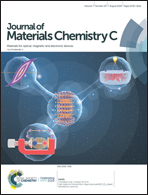Facile synthesis of TiO2/In2S3/CdS ternary porous heterostructure arrays with enhanced photoelectrochemical and visible-light photocatalytic properties
Abstract
In this paper, TiO2/In2S3/CdS ternary porous heterostructure arrays are successfully synthesized on FTO (fluorine-doped tin oxide) substrates through a hydrothermal reaction and an in situ cation exchange method. The microstructure, morphology, and composition, as well as the optical, photoelectrochemical and photocatalytic properties, of the obtained samples are studied. The results demonstrate that the TiO2/In2S3/CdS ternary heterostructure arrays can significantly enhance the separation rate of electron–hole (e−–h+) pairs, improve the absorption of visible light, and augment the photoelectrochemical and photocatalytic properties. The resulting photocurrent density (0.18 mA cm−2) and photodegradation efficiency (58.8%) of TiO2/In2S3/CdS (30 min) are approximately 18 and 6 times higher than those of TiO2 nanorod (TNR) arrays, respectively. The excellent performance can be ascribed to the synergistic effect of the components in the TiO2/In2S3/CdS ternary porous heterostructure arrays, such as (i) the presence of a double type-II band alignment at the interfaces, (ii) increasing the absorption of visible light through the large specific surface area of porous In2S3, and (iii) the ideal band gaps of In2S3 and CdS.



 Please wait while we load your content...
Please wait while we load your content...